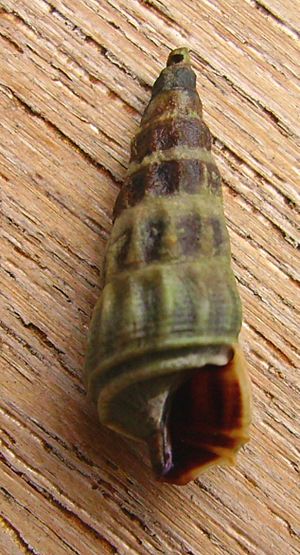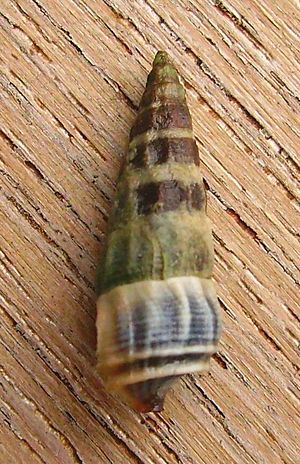Zeacumantus lutulentus facts for kids
Quick facts for kids Zeacumantus lutulentus |
|
|---|---|
 |
|
| Apertural view of a shell of Zeacumantus lutulentus. | |
| Scientific classification | |
| Kingdom: | |
| Phylum: | |
| Class: | |
| (unranked): |
clade Caenogastropoda
clade Sorbeoconcha |
| Superfamily: |
Cerithioidea
|
| Family: |
Batillariidae
|
| Genus: |
Zeacumantus
|
| Species: |
Z. lutulentus
|
| Binomial name | |
| Zeacumantus lutulentus (Kiener, 1841)
|
|
| Synonyms | |
|
|
Zeacumantus lutulentus is a type of medium-sized sea snail. It's also known as a mud snail because it often lives in muddy areas. This amazing creature is a marine gastropod mollusk, which means it's a snail that lives in the ocean and has a soft body usually protected by a shell. It belongs to a group of snails called the horn snails.
Contents
Discovering the Mud Snail
Zeacumantus lutulentus is a fascinating sea snail. It was first described in 1841 by a scientist named Louis Charles Kiener. This snail is part of the Batillariidae family. This family includes many snails that live in muddy or sandy parts of the ocean.
What is a Gastropod?
A gastropod is a type of mollusk. This group includes snails and slugs. They are known for having a single shell, or sometimes no shell at all. Gastropods move around on a muscular "foot." They use this foot to glide over surfaces.
Marine Gastropods
Zeacumantus lutulentus is a marine gastropod. This means it lives in the ocean. Marine gastropods can be found in many different ocean environments. Some live on rocky shores, while others prefer sandy or muddy bottoms.
Where Does the Mud Snail Live?
This species of mud snail is found in two main places. It lives in the waters around New Zealand. It also lives in parts of Australia. These areas provide the right conditions for the snail to thrive.
Preferred Habitat
Zeacumantus lutulentus often lives in estuaries. An estuary is where a river meets the sea. These areas have a mix of fresh and salt water. They are usually muddy or sandy. The snails can bury themselves in the soft mud. This helps them stay safe from predators.
What Does the Mud Snail Eat?
Most mud snails are detritivores. This means they eat detritus. Detritus is dead organic material. It includes tiny bits of plants and animals that have settled on the seafloor. The snails use their special mouthparts to scrape up this food.
How They Feed
Mud snails have a ribbon-like structure called a radula. The radula is covered in tiny teeth. They use it like a file to scrape food particles. This helps them get nutrients from the mud and sand. They play an important role in cleaning up their environment.
The Mud Snail's Shell
The shell of Zeacumantus lutulentus is a key feature. It is medium-sized and usually has a spiral shape. The shell protects the soft body of the snail. It also helps the snail hide from animals that might want to eat it.
Shell Appearance
The shell often has a dull or muddy color. This helps it blend in with its environment. The surface of the shell might have ridges or bumps. These features can help the snail grip surfaces or provide extra protection. Each shell is unique, like a fingerprint.
Life Cycle of the Mud Snail
Like many snails, Zeacumantus lutulentus starts its life as an egg. The eggs are usually laid in the water. They hatch into tiny larvae. These larvae float in the ocean for a while. They are very small and can be carried by currents.
Growing Up
After some time, the larvae settle down. They then develop into juvenile snails. These young snails look like tiny versions of the adults. They grow bigger over time, adding new layers to their shells. As they grow, they become more like the adult snails we see.
Importance of Mud Snails
Mud snails like Zeacumantus lutulentus are important to their ecosystems. They help to recycle nutrients. By eating detritus, they break down dead material. This process releases nutrients back into the water. These nutrients can then be used by other organisms.
Food Source
These snails also serve as a food source for other animals. Many fish, crabs, and birds eat snails. This makes them an important part of the food web. They help support the lives of many other creatures in their habitat.


